Bulletin – December 2017 Finance The Availability of Business Finance
- Download 1.62MB
Abstract
Access to business finance has improved markedly since the global financial crisis, and debt-servicing costs are near historic lows. Nevertheless, small businesses continue to face challenges accessing finance. This article looks at the sources and availability of finance for Australian businesses. It also explores several innovations, such as comprehensive credit reporting and alternative finance platforms. These could make financing more accessible for small businesses in the start-up or expansion phase.
Introduction
The Reserve Bank monitors the availability of business finance using information from a wide range of sources. These include financial data collected by the Australian Prudential Regulation Authority (APRA) or reported by companies, surveys and the Bank's regular liaison with financial institutions and businesses. Every year for the past 25 years, the Bank has convened a Small Business Finance Advisory Panel to better understand the challenges faced by innovative small businesses. To gain a variety of perspectives, the Bank invites entrepreneurs from a range of industries and locations across Australia to join the panel for terms of three years. Access to finance for small businesses in the start-up and expansion phase of their existence is important, since these firms generate employment, drive innovation, and boost competition in markets.
Overall, external finance has become more readily available over recent years. Interest rates on business loans and corporate bonds are near historic lows, mainly because monetary policy is expansionary and credit spreads have narrowed.
Foreign banks have been expanding their operations in Australia, competing vigorously with the domestic banks to lend to large established businesses. Surveys and the Bank's business liaison indicate that businesses generally face little difficulty accessing finance. Despite this, growth in business borrowing has only been moderate over recent years and equity raisings have been relatively subdued. This has been partly because the domestic banks have scaled back their exposures to certain higher-risk sectors, such as commercial property. More generally, large businesses have demanded less finance to fund mergers and acquisitions. Resource companies have also reduced debt recently, using the boost to their cash flows from higher commodity prices.
In contrast to large businesses, it remains challenging for young small businesses to fund their expansion plans. Prudent lenders require evidence that a business can service the loan from its cashflow; this is difficult for an entrepreneur starting a business to demonstrate. To obtain a bank loan of sufficient size at a reasonable interest rate, entrepreneurs often need to provide personal guarantees and collateral. This concentrates their risk and excludes those who do not have existing wealth to draw upon. Given the risk profile of start-up businesses, equity financing would often be more appropriate, but there have been few avenues for such financing in Australia.
There are several innovations that could improve access to finance for start-up businesses. In particular, comprehensive credit reporting should provide all lenders with richer information about potential borrowers, reducing the costs of credit assessment. In addition, large technology companies have started to exploit rich data from their sales or payments platforms to identify promising business lending opportunities. Alternative funding platforms also offer new sources of finance for entrepreneurs. While these developments remain in their infancy, take-up is likely to expand over the period ahead.
The Sources and Uses of Business Funding
Looking at the balance sheet of the business sector in Australia, businesses are financed by around 60 per cent equity and 40 per cent debt and trade credit (Table 1). Equity liabilities include the equity of larger businesses listed on stock exchanges and the unlisted equity of smaller businesses, foreign subsidiaries and public corporations. Business debt is dominated by loans from financial institutions, with debt securities playing a relatively minor role. This capital structure is similar to most other comparable advanced economies (Graph 1). The United States, to which Australia is often compared, is actually something of an outlier. Overall, bank loans are a much smaller share of business funding in the US.
| Liabilities | $ billion | Share of total liabilities | Assets | $ billion | Share of total assets |
|---|---|---|---|---|---|
| Per cent | Per cent | ||||
| Debt | 1,340 | 34 | Financial assets | 1,178 | 27 |
| Loans | 1,050 | 26 | Deposits and cash | 502 | 12 |
| Debt securities | 290 | 7 | Debt securities and loans | 92 | 2 |
| Equity | 2,425 | 61 | Equity assets | 336 | 8 |
| Listed equity | 1,066 | 27 | |||
| Unlisted equity | 1,359 | 34 | |||
| Trade credit | |||||
| Accounts payable | 216 | 5 | Accounts receivable | 248 | 6 |
| Non-financial assets | 3,164 | 73 | |||
| Total liabilities | 3,980 | 100 | Total Assets | 4,342 | 100 |
| Balancing item | 361 | ||||
|
(a) The finances of the business sector are challenging to measure, since the boundary between businesses, households and the government is not clearly defined and evolves over time. Unincorporated businesses tend to be closely intertwined with the households that own them and, as a result, it is virtually impossible to separately identify their balance sheets. In addition, the privatisation of many public corporations over recent decades has shifted the responsibility for financing these businesses from the public sector to the private sector. To deal with these challenges, the business sector is defined here to include all private and public non-financial corporations. The balance sheet of the business sector is presented on a consolidated basis, where claims between businesses within the sector have been netted to remove double counting. Sources: ABS; RBA |
|||||
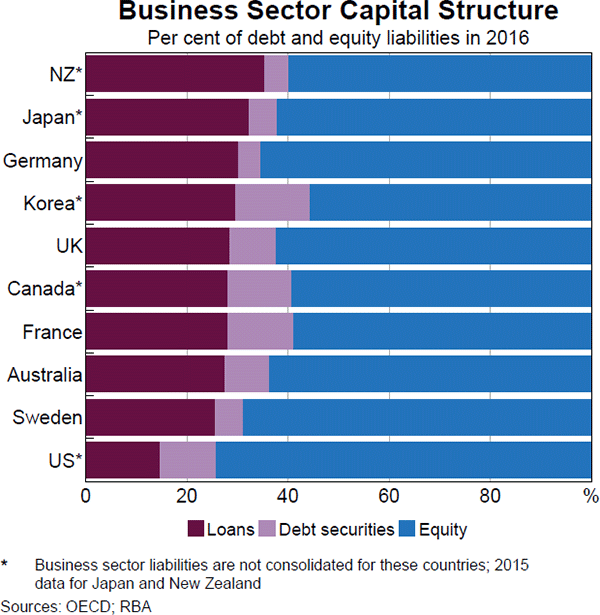
The liabilities of the business sector are mainly used to finance productive non-financial assets, such as commercial buildings, machinery and intellectual property. This accounts for about three-quarters of the balance sheet, while the remainder is invested in financial assets.
The primary source of new finance for businesses is internal funding (that is, profits net of interest and tax), supplemented by funds raised externally (Graph 2). Funds are largely used to finance productive investment, but some share is used to pay dividends and invest in financial assets. Businesses tend to finance their investment from internal funding, because raising funds externally is more costly and can involve investors demanding a level of control over the business.[2] Investment has moved broadly in line with the amount of internal funding available.
Over the past 10 years or so, the pattern of internal funding for Australian businesses overall has been affected by the commodity price cycle. Resource companies largely used their higher profits from the mid 2000s to the mid 2010s to finance the resource investment boom. As commodity prices fell from 2011 to 2015, resource companies scaled back their investment, and returned a higher proportion of their profits to shareholders as dividends. Following the recovery in commodity prices from the lows of early 2016, resource companies have been using the boost to internal funds to repay debt and rebuild their deposit balances.
In contrast to internal funds, those raised externally are often used to finance mergers and acquisitions (M&A) activity. This is evident in the aggregate data, where debt funding moves more closely with M&A activity than with investment (Graph 3). [3] The period leading up to the global financial crisis was a clear example, when several highly leveraged M&As took place.
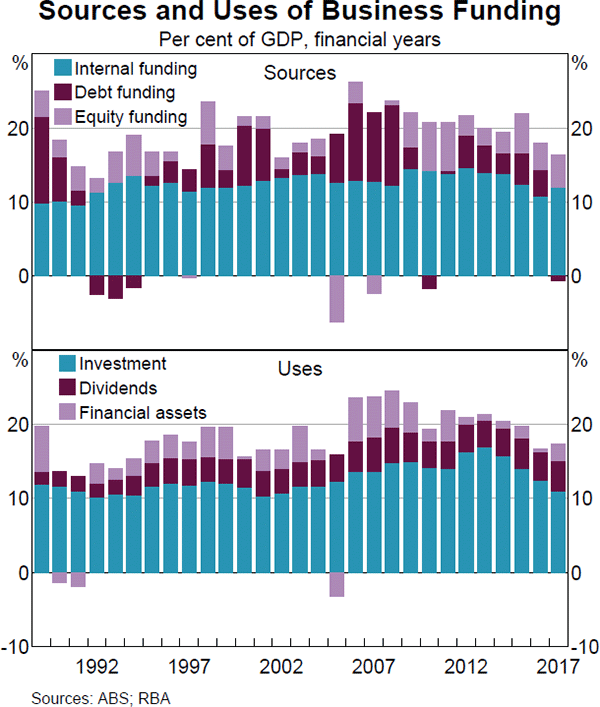
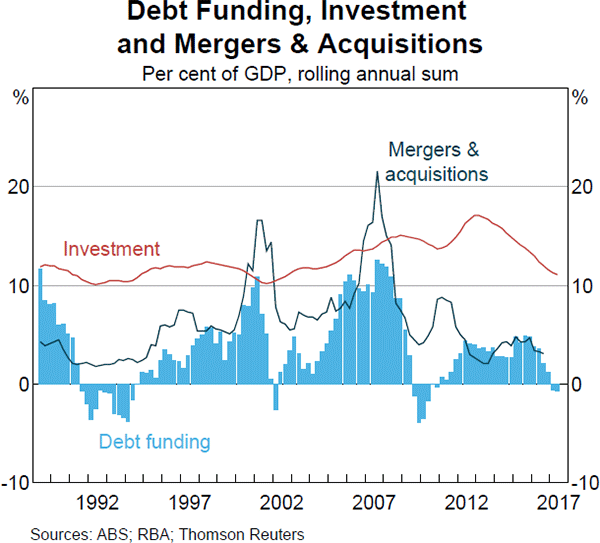
When businesses choose to raise external funds, they are influenced by the relative costs of the various funding sources. Internal funds are generally viewed as the cheapest source, then external debt, while equity is the most expensive option, since it involves diluting the ownership of the business. Over recent decades, there has tended to be an inverse relationship between debt and equity funding; businesses raised larger amounts of debt during economic upswings, and raised more equity at times when the supply of debt funding was less favourable, such as following the early 1990s recession and the global financial crisis.
Over recent years, a higher share of business borrowing has been from foreign institutions (Table 2). Foreign banks, particularly those domiciled in Asia, have been increasing their share of the domestic loan market. This has occurred both through their Australian branches (included in lending by authorised deposit-taking institutions (ADIs) in Table 2) and from their head offices participating in loan syndications (included in offshore lending in Table 2). Offshore debt securities funding has also become more important, at least for large corporations with investment-grade credit ratings. The domestic bond market is small, as Australian investment funds invest relatively little of their assets in fixed-income products.
| Average over 10 years to: | ||||
|---|---|---|---|---|
| 1997 | 2007 | 2017 | End June 2017 | |
| Debt, share lent by: | ||||
| Authorised deposit-taking institutions (ADIs) | 54 | 59 | 54 | 49 |
| Investment funds | 8 | 9 | 6 | 5 |
| Government | 14 | 9 | 10 | 9 |
| Households | 0 | 0 | 0 | 0 |
| Offshore | 24 | 23 | 31 | 38 |
| Equity, share owned by: | ||||
| ADIs | 2 | 2 | 1 | 1 |
| Investment funds | 18 | 27 | 29 | 29 |
| Government | 30 | 19 | 15 | 15 |
| Household | 25 | 22 | 20 | 20 |
| Offshore | 26 | 31 | 35 | 36 |
|
Sources: ABS; RBA |
||||
Listed equity raisings have been subdued over the past 10 years, with relatively little capital raised through initial public offerings (IPOs) (Graph 4). This followed a period of significant equity raisings during the 2000s, partly driven by a number of privatisations through public floats. Over recent years, privatisations have increasingly been through private sales to investment funds and offshore investors, which do not contribute to listed equity raisings. As a result of these privatisations, the share of government ownership of the business sector has halved since the 1990s (Table 2).
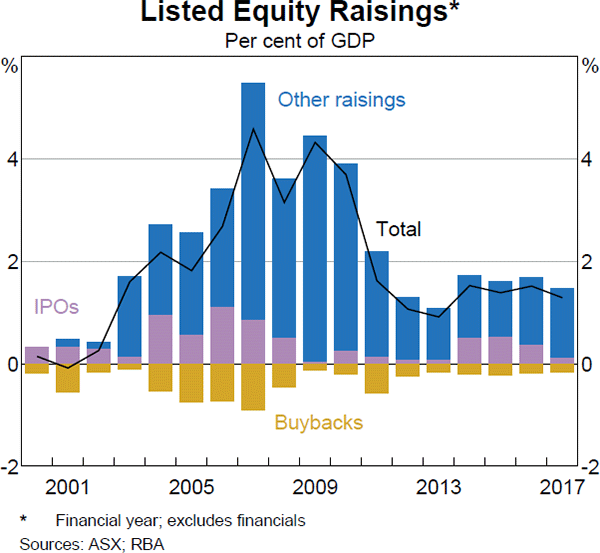
Cost and Availability of Finance
Overall, external finance has become more readily available over recent years. Monetary policy (in Australia and abroad) is accommodative and interest rates on business loans and corporate bonds are near historic lows. Consistent with this, the interest being paid by businesses relative to their operating profits is around its lowest level since the early 1960s (Graph 5). The decline in interest paid since the late 1980s has been driven entirely by lower interest rates; the ratio of debt relative to operating profits has increased a little over this period. In addition, the messages from business surveys and the Bank's liaison program are that funding conditions have improved over the past five years (Graph 6). One notable exception has been the commercial property sector, where the domestic banks have sought to rein in their exposures. This has partly been in response to active prudential supervision from APRA (Byres 2017). In addition, small businesses tend to find it more challenging to obtain finance than large businesses.
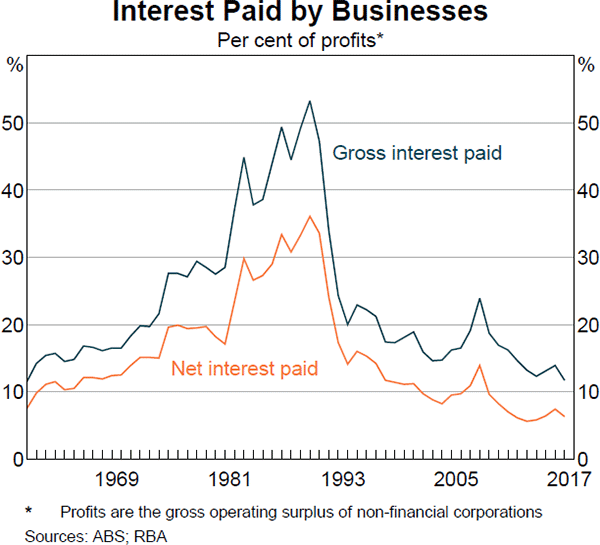
Despite finance generally being available, growth in business borrowing has been relatively moderate, suggesting demand has been soft. Following the global financial crisis, the corporate sector deleveraged, and outside the resources sector, gearing has remained low since then (Graph 7). Recently, non-mining business investment has been growing and the outlook for investment has improved. Demand for external finance nonetheless remains moderate, consistent with subdued M&A activity and firms relying on internal funding for investment. Even in the resources sector, while gearing rose between 2011 and 2015, it did not reach the levels that prevailed immediately before the crisis. It has since declined again, as companies have used their higher cash flows to pay down debt.
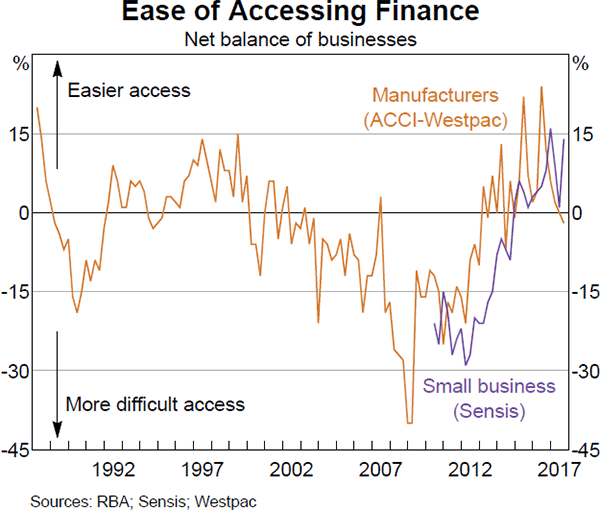
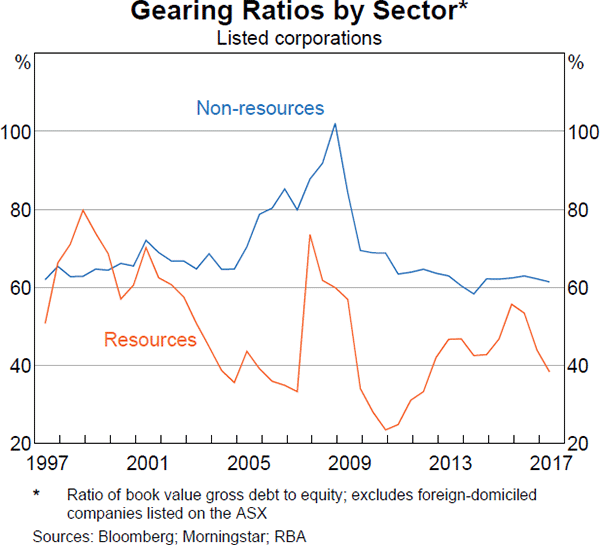
Finance for Small Businesses
A consistent theme from the Small Business Finance Advisory Panel over the years has been that access to finance for small businesses remains challenging. According to the Australian Bureau of Statistics (ABS), small businesses were around twice as likely as large businesses to identify a lack of access to additional funds as a barrier for their business. In this context, it is important to distinguish between small businesses that are in the start-up or expansion phase, which have a strong demand for external finance, and the many small businesses that are not expanding and have little need for external finance; according to the ABS, less than a fifth of small businesses actually sought external finance in 2015/16. RBA research has found that financial constraints can discourage potential entrepreneurs from starting businesses and prevent small businesses from undertaking investment.[4] The remainder of this section focusses on the issues affecting access to finance for small businesses in the start-up or expansion phase. These businesses are more likely than other small businesses to boost employment, innovate and provide a degree of competition for established businesses.
According to lenders, smaller businesses find it harder to obtain external finance since, on average, they are riskier investments and there is less information available to lenders and investors about their prospects. Lenders want evidence that borrowers can repay loans from the cash flow of their businesses. This is particularly challenging for new businesses. Applications from start-up businesses require more detailed risk assessment than for existing small businesses, which raises the cost of originating the loan. Lenders typically manage these risks by charging higher interest rates than for large business loans. They also reject or modify a greater proportion of small business credit applications. In particular, lenders noted in liaison that they were less likely to lend to a start-up in a new or emerging industry.
The reduction in the risk appetite of lenders following the global financial crisis appears to have had a more significant and persistent effect on the cost of finance for small business. The average spread of business lending rates to the cash rate widened, but most markedly for small business (Graph 8). This reflected an increase in the assessed riskiness of small business loans. In turn, this reflected a larger increase in non-performing loans for small businesses than for residential mortgages or large business lending portfolios (apart from commercial property exposures, which experienced higher defaults). This experience has been built into the default probabilities that the major banks apply to their lending portfolios (Graph 9).
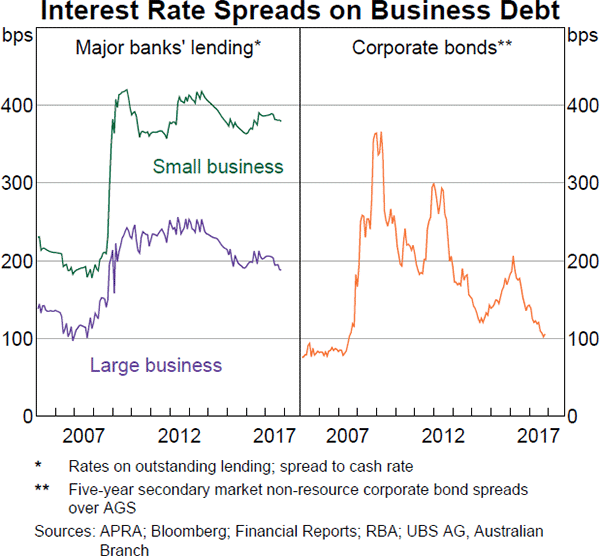
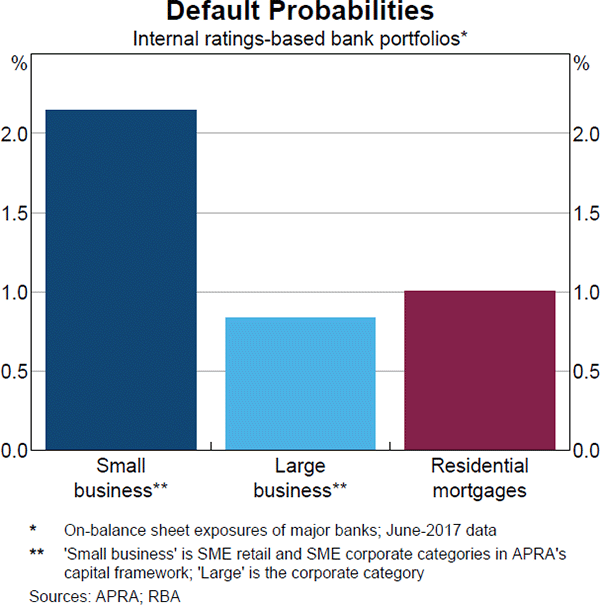
Over recent years, there has been strong competition for large business lending. Large businesses have access to deeper funding markets than small businesses, including global markets for corporate bonds and syndicated lending. Much of the competition from banks for large business loans has been driven by an expansion in activity by foreign banks. That expansion has been reflected in a decline in the interest rate spread on large business lending. According to the Bank's liaison with businesses and banks, these foreign banks are most interested in lending to large highly rated Australian companies.
In contrast, competition has been less vigorous for small business lending and the interest rate spread for this lending has remained relatively high. Consistent with this, the share of lending provided by the major banks is over 80 per cent for small businesses; this compares to around two-thirds for large businesses. Small businesses continue to use loans from banks for most of their debt funding because it is often difficult and costly for them to raise funds directly from capital markets.
The Bank's liaison with lenders and businesses has highlighted that the availability of housing collateral by small business borrowers has a significant effect on the cost and availability of debt finance (Connolly, La Cava and Read 2015). Lenders place most weight on evidence of the capacity of small business borrowers to service their debts on an ongoing basis from their cash flows. Pledging collateral nonetheless demonstrates the borrower's willingness to repay, and serves as a backstop that would help protect the lender in the event of default. Lenders have indicated that at least three-quarters of their small business lending is collateralised and that they have a limited appetite for unsecured lending. A high proportion of larger lending facilities tend to be lent at interest rates close to those that apply to housing loans, suggesting that housing collateral has been provided. In contrast, small facilities are more likely to be lent at much higher rates consistent with unsecured lending (Graph 10). This suggests that the availability of housing collateral influences the interest rate charged and the size of the loan. Entrepreneurs are often uncomfortable with providing their personal residence as collateral for their business borrowing, since it concentrates the risk they face if the business fails. Entrepreneurs have limited options for providing alternative collateral, as banks are far more likely to accept marketable, physical assets than ‘soft’ assets, such as software and intellectual property.
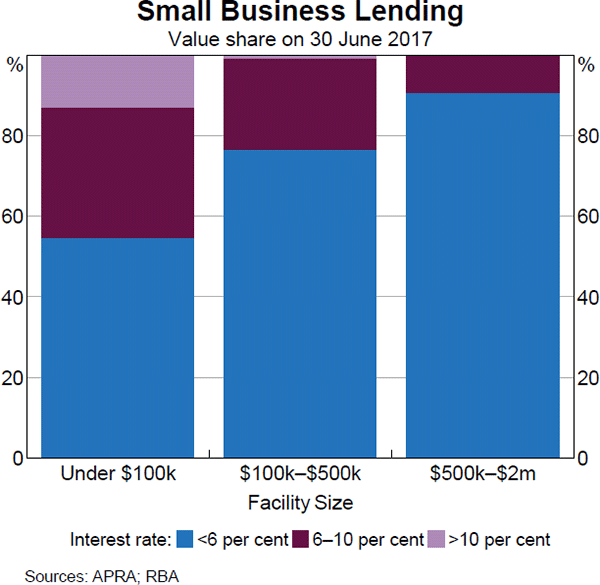
Small businesses have also raised concerns about the unfavourable trade credit terms they face from suppliers and customers with more market power, such as larger businesses and government. According to the ABS, around 15 per cent of small businesses identified cash flow constraints due to the provision of trade credit as an impediment to their business, compared to only 2 per cent of large businesses. In response to these concerns, the Australian Small Business Ombudsman conducted a Payment Times and Practices Inquiry in April 2017. Following this, the Australian Government has recently committed to expedite its payment of invoices from small businesses. Business-to-business payments data from illion (formerly Dunn and Bradstreet) indicate that more businesses have been settling their invoices on time in recent months.
Given the higher risk associated with small businesses, particularly start-ups, equity financing would appear to be more appropriate than traditional bank finance. However, small businesses often face difficulty accessing equity financing beyond the founders' contributions. Small businesses have little access to listed equity markets. While venture capital funding has risen in recent years, its supply to small businesses is limited in Australia, particularly relative to many other advanced economies (Graph 11). Private companies can only offer investments to professional, sophisticated or experienced investors, or make small-scale personal offers. Small businesses also report that the cost of equity financing is high, and they are often reluctant to sell equity to professional investors since this usually involves relinquishing significant control over their business.
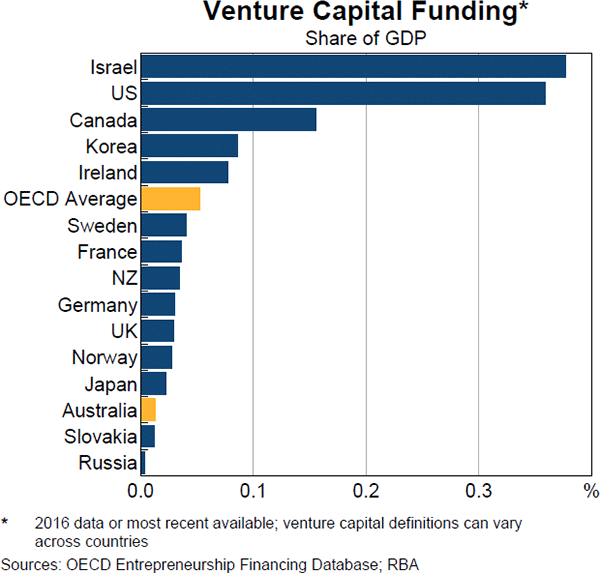
Innovations Improving Access to Business Finance
There are several innovations that could improve access to finance. These provide lenders with more information about the capacity of borrowers to service their debt, or connect risk-seeking investors with start-up businesses that could offer high returns.
Comprehensive credit reporting and open banking
Comprehensive credit reporting would provide more information to lenders about the credit history of potential borrowers compared with the current standard of making only negative credit information publicly available. This would reduce the cost of the credit assessment process by allowing lenders to price risk more accurately. It could also reduce the need for lenders to seek additional collateral and personal guarantees for small business lending, particularly for established businesses. In particular, the use of personal guarantees is more widespread in Australia than other countries, such as the United Kingdom and the United States, that have well-established comprehensive credit reporting regimes.
For several years, there have been industry-led efforts to establish a voluntary comprehensive credit reporting regime in Australia. A recent report by the Productivity Commission highlighted that participation has so far been limited and suggested that widespread use of such a regime could improve access to credit for small business borrowers (Productivity Commission 2017). Consistent with the recommendations of the Productivity Commission, the Australian Government has announced that it will legislate for a mandatory regime to come into effect in mid 2018. In response to these developments, several of the major banks have announced commitments to begin contributing their credit data over the year ahead.
The introduction of an open banking regime would make it easier for entrepreneurs to share their transactions data securely with third-party service providers, such as potential lenders. The Australian Government has announced that it will introduce an open banking regime and is currently conducting an independent review, which is to report by the end of the year.
Large technology companies
Large technology companies can use data on their business customers to provide financial services, such as term loans and trade finance, in competition with the banks. In particular, technology firms can use the transactional data from their sales or payments platforms to identify creditworthy borrowers, and can provide loans to these businesses from their own balance sheets. This could provide small, innovative businesses that are active on these online platforms with a new source of finance. However, a disadvantage from the perspective of the business borrower is that, if a loan were to fall into arrears, the technology firms would be able to freeze assets or restrict access to the platform.
Amazon and PayPal, for example, provide finance to some businesses that use their platforms, primarily in the United States. According to company announcements, Amazon and PayPal have each lent more than US$3 billion to businesses over recent years. Some large Chinese technology firms, such as Alibaba and Tencent, have also started providing financial services in recent years. Some of these companies use algorithms to identify businesses with good sales histories and offer them finance on an invitation-only basis. For one provider, loans are reported to range up to US$750,000 for terms of up to one year at interest rates between 6 and 14 per cent, with repayments automatically deducted from the borrower's sales proceeds. Providers of online accounting software are also offering loans to small business customers based on the health of their accounts.
Alternative finance platforms
Alternative finance platforms, including marketplace lending and crowdfunding platforms, use new technologies to connect fundraisers directly with funding sources. Their aim is to avoid the costs and delays involved in traditional intermediated finance. While alternative financing platforms are growing rapidly, at this stage they remain a very minor source of funding for businesses, including in Australia. The Australian market is reported to have commenced around 2013 and provided around $600 million in finance to businesses in 2016.[5] The largest alternative finance markets are in China, followed by the United Kingdom and the United States. However, all of these markets remain small relative to the size of their economies (Graph 12).
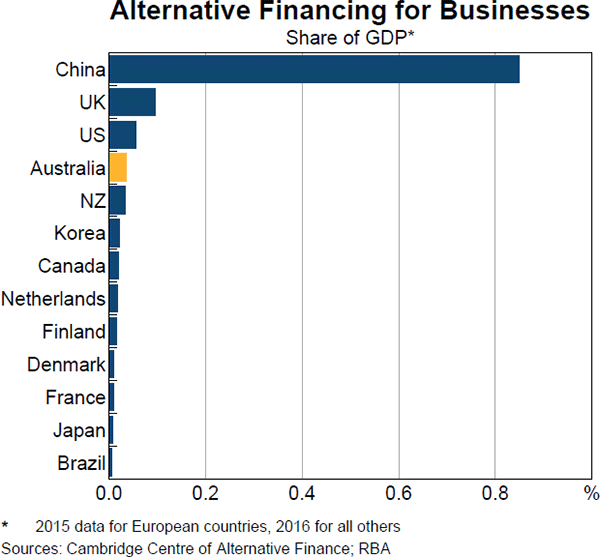
The Australian Government and financial regulators are seeking to facilitate innovation in business financing. The Australian Securities and Investments Commission (ASIC) has set up an Innovation Hub to assist financial technology start-ups to navigate the regulatory system. The Australian Government has made several legislative changes to facilitate sustainable growth in these markets, including allowing small unlisted public companies to raise crowd-sourced equity.
Marketplace lending platforms provide debt funding by matching individuals or groups of lenders with borrowers. These platforms typically target personal and small business borrowers with low credit risk by offering lower-cost lending products and more flexible conditions than traditional lenders. Data collected by ASIC indicate that most marketplace lending in Australia is for relatively small loans to consumers at interest rates comparable to personal loans offered by banks (Graph 13; ASIC 2017).
It is unclear whether marketplace lending platforms are significantly reducing financing constraints for small businesses. Marketplace lenders do not have an information advantage over traditional lenders. As a result, they need to manage risks with prices and terms in a similar manner to traditional lenders. Moreover, a survey by the Federal Reserve found that US small businesses were noticeably less satisfied with online lenders than with traditional lenders. There were more complaints about the interest rates charged and the repayment terms imposed by online lenders (Graph 14; Federal Reserve 2017). Nevertheless, these platforms could provide some competition to traditional lenders since they process applications quickly and offer rates below those on credit cards.
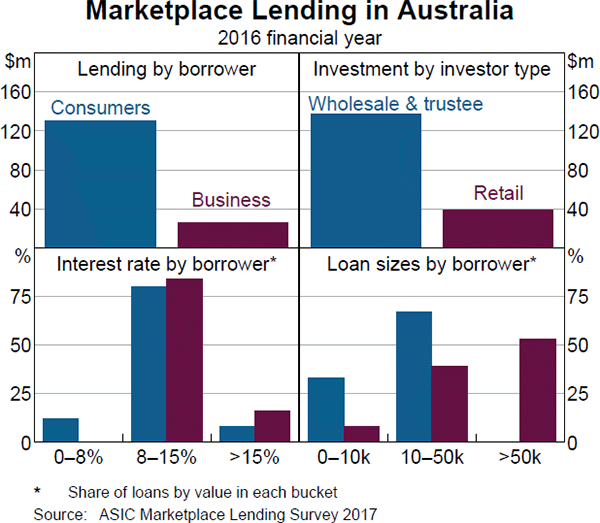
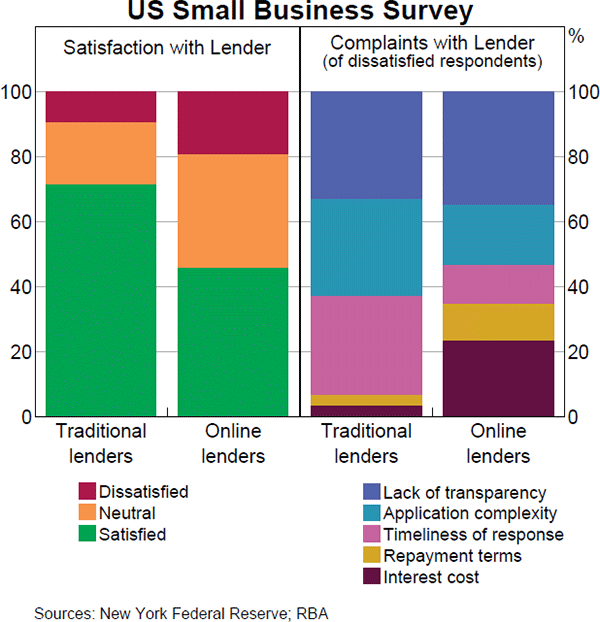
Crowdfunding platforms could make financing more accessible for start-up businesses, but their use for business funding has been limited to date. Crowd-sourced equity funding platforms typically involve a large number of investors taking a small equity stake in a business. As a result, entrepreneurs can receive finance without having to give up as much control as demanded by venture capitalists. Some crowdfunding platforms also allow businesses to raise funds through presales of a new product.
These platforms offer some advantages to small business since they receive direct funding from customers, require no collateral and can gauge market interest. However, success on these markets is unpredictable and the sites are geared towards providing consumer-oriented products. Even so, crowdfunding has some high-profile success stories in Australia.
Conclusion
Access to finance is important for the economy, since businesses need funding for their day-to-day operations and to undertake investment. Overall, external finance has become more readily available since the global financial crisis, and business interest rates are near historic lows. Large established businesses have access to a wide range of funding sources. However, it remains more challenging for young, small businesses to fund their expansion plans. There are several financial innovations that could improve their access to finance, such as comprehensive credit reporting and access to alternative funding platforms.
Footnotes
The authors are from Domestic Markets Department. [*]
Previous RBA research has found a significant relationship between investment and variables such as the user cost of capital, cash flow, sales, business confidence and the terms of trade: La Cava (2005) and Cockerell and Pennings (2007). [2]
The ABS data on business debt funding, which is a broad measure of loans and debt securities, have been weaker over the past year than RBA business credit, which measures lending to businesses by financial institutions that report to APRA. The weaker ABS data are likely to reflect companies repurchasing debt securities and reducing offshore borrowing, particularly in the resources sector, and the repayment of government loans following the privatisation of some public corporations. [3]
See La Cava and Windsor (2016), Kenney, La Cava and Rodgers (2016) and Connolly, La Cava and Read (2015). [4]
See Cambridge Centre for Alternative Finance and Australian Centre for Financial Studies (2017). [5]
References
ASIC (Australian Securities and Investments Commission) (2017), Survey of Marketplace Lending Providers, Final Report, June.
Byres W (2017), ‘Prudential Perspectives on the Property Market’, Remarks at CEDA's 2017 NSW Property Market Outlook, Sydney, 28 April.
Cambridge Centre for Alternative Finance and Australian Centre for Financial Studies (2017), Cultivating Growth – The 2nd Asia Pacific Region Alternative Finance Industry Report, Final Report, September.
Cockerell L and S Pennings (2007), ‘Private Business Investment in Australia’, RBA Research Discussion Paper No 2007–09.
Connolly E, G La Cava and M Read (2015), ‘Housing Prices and Entrepreneurship: Evidence for the Housing Collateral Channel in Australia’, A Moore and J Simon (eds), Small Business Conditions and Finance, Proceedings of a Conference, Reserve Bank of Australia, Sydney, pp 115–144.
Federal Reserve (2017), ‘Small Business Credit Survey’. Available at <https://www.newyorkfed.org/medialibrary/media/smallbusiness/2016/SBCS-Report-EmployerFirms-2016.pdf>.
Kenney R, G La Cava and D Rodgers (2016), ‘Why Do Companies Fail?’, RBA Research Discussion Paper No 2016-09.
La Cava G (2005), ‘Financial Constraints, the User Cost of Capital and Corporate Investment in Australia’, RBA Research Discussion Paper No 2005-12.
La Cava G and C Windsor (2016), ‘Why Do Companies Hold Cash?’, RBA Research Discussion Paper No 2016-03.
Productivity Commission (2017), Data Availability and Use: Overview & Recommendations, Report No 82, Canberra.